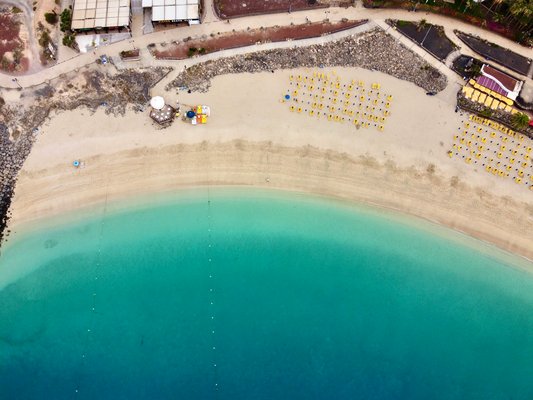This port city on Fuerteventura's east coast is the island's capital and main commercial hub, with a waterfront lined by local restaurants and 1940s colonial buildings.
Puerto del Rosario became Fuerteventura's capital in 1860, serving as a busy port where cargo ships dock alongside passenger ferries. Walk along the harbor to see modernist sculptures like the giant metal seagull near the cruise terminal, or spend an afternoon at the Miguel de Unamuno House Museum where the Spanish writer lived during his exile. The town changed its name from Puerto de Cabras in the 1950s but still feels like a place where fishermen mend nets and families gather at beachside cafes. Playa Chica beach provides wheelchair access through its wooden walkways, and you can watch ferries arrive from Gran Canaria while sunbathing. From here, you're within 45 minutes' drive of sand dunes at Corralejo and volcanic craters near Tindaya mountain.
Central Puerto del Rosario: Where to Begin
Start on Calle Primero de Mayo, a pedestrian street where cafes serve café con leche under striped awnings. Look for buildings with traditional Canarian wooden balconies painted dark green against whitewashed walls. The Church of Nuestra Señora del Rosario stands three blocks inland, its stone facade mixing arched windows with a bell tower topped by a red clay roof. Five blocks east, the Miguel de Unamuno House Museum displays the philosopher's desk, bed, and personal letters in rooms kept as they were during his 1924 stay. Follow the Sculpture Trail markers to find over 150 artworks along streets and traffic circles, including a bronze figure balancing on one leg near the post office and carved lava rock formations outside the tax office.
Coastal Areas and Beaches
Playa Chica's compact beach sits a five-minute walk from the town hall, with gentle waves suitable for beginner swimmers. Walk south along the paved promenade past fishing boats to reach Playa Blanca, where yellow sand stretches for 800 meters and kiteboarders launch colorful sails on windy afternoons. For a less crowded spot, take bus line 3 north to Puerto Lajas Beach, where black volcanic sand contrasts with bright blue fishing huts. All beaches have freshwater showers, and from June to September, red-flagged lifeguard towers operate from 10 AM to 6 PM. Try the beach bars near Playa Blanca's parking lot for fried squid with mojo verde sauce made from cilantro and garlic.
Local Culture and Events
In 2011, artists painted 12 murals across the city—search for the giant octopus wrapping its tentacles around a building near the ferry terminal. Every Friday morning, the Mercado de Puerto fills Plaza de San Juan with stalls selling prickly pears, handmade knives, and wheels of Majorero goat cheese coated in paprika. Drive 20 minutes west to La Alcogida Eco-Museum, where staff in traditional dress demonstrate how farmers made cheese using fig sap as rennet and wove roofs from palm leaves. October brings the Fiesta de la Virgen del Rosario, with children parading in starched white dresses and drum bands playing at midnight. Check the schedule at the seafront congress center for flamenco shows or Canarian folk music concerts.
Nearby Destinations Worth Visiting
Corralejo, 30 minutes north by car, gives access to ferry services to Lanzarote and hiking routes through dunes where rare cream-colored courser birds nest. South of the capital, Caleta de Fuste's curved bay protects snorkelers from strong currents—rent gear from shops near the 18th-century Torreón fortress. Ferries from Puerto del Rosario's dock reach Las Palmas de Gran Canaria in 90 minutes, letting you explore the colonial architecture of Vegueta district before returning the same day. On Fuerteventura itself, drive into Betancuria Rural Park to see cave paintings left by the original Guanche inhabitants and stone pens where shepherds once kept goats.
Getting Around and Staying Here
Fuerteventura Airport handles flights from Madrid, Barcelona, and Frankfurt, with a taxi to downtown costing about €15. Buses depart every 30 minutes from the station on Avenida Juan de Bethencourt—Line 1 goes south to Morro Jable past the airport, while Line 8 heads northwest to El Cotillo's tidal pools. Hotel El Mirador sits directly on the promenade, with rooms overlooking fishing boats unloading their catch at dawn. For dinner, locals favor El Horno de Ana near the church for herbed-roasted goat, or Marisquería La Lonja by the fish market for yesterday's catch turned into garlic shrimp or grilled wreckfish. Keep sneakers with grip soles for walking on uneven paths near old limestone quarries east of town.

















